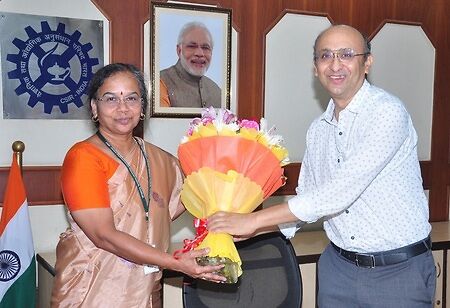
Dr. N Kalaiselvi: The First Women Director of CSIR


There is always a competition between evolution and existence. The contribution of science and technology to the present world is remarkable. In 1930, the science and technology industries started to emerge. As the British were ruling our nation, eminent citizens such as C. V. Raman, Lt. Col. Seymour Sewell, and J. C. Ghosh had put forward the idea of creating an advisory board of scientific research. Sir Richard Gregory, then editor of Nature, was among the first people to officially report to the British government. When World War II started in 1939, the British government decided to use its wealth to help the war effort. To make room for a Board of Scientific and Industrial Research, the Bureau was terminated by the recommendation of Arcot Ramaswamy Mudaliar. As he was a member of the Viceroy’s executive council, his recommendation was agreed upon by the British government. On the 1st of April 1947, the Board of Scientific and Industrial Research (BSIR) was created through Mudaliar’s recommendation.
Since then, the Research organization has created history by developing and researching vegetable oil blends as fuel, plastic packing cases for army boots and ammunition, dyes for uniforms, and preparation of vitamins. Mudaliar became the chair of the board, and Bhatnagar was appointed the director. The BSIR was allocated an annual budget of Rs.5, 00,000 under the Department of Commerce. By the end of 1940, about 80 researchers were engaged, of whom one-quarter were directly employed. The remarkable achievements of BSIR included the development of the techniques for the purification of Balochistan sulfur anti-gas cloth manufacture, vegetable oil blends as fuel and lubricants, plastic packing cases for army boots and ammunition, dyes for uniforms and the preparation of vitamins, and the invention of a pyrethrum emulsifier and cream. In early 1941 Bhatnagar persuaded the government to set up an Industrial Research Utilisation Committee (IRUC) for translating results into application. The government then agreed to make a separate fund out of the royalties received from industry for further investment into industrial research. Mudaliar recommended that an Industrial Research Fund be constituted, which would have an annual grant of Rs. 10, 00,000 for five years. The Central Assembly accepted the proposal in Delhi at its session on the 14th of November 1941.
To advance the organization in Industrial research and development, the autonomous body was created on the 26th of September, 1942, named The Council of Scientific & Industrial Research (CSIR). The contemporary R&D organization, CSIR, is known for its cutting-edge R&D knowledge base in diverse S&T areas. The organization appears all over India.
Regarding Intellectual property, CSIR has 2971 patents in force internationally and 1592 patents in India. CSIR has offered 14000 patents worldwide since its inception. CSIR was awarded the National Intellectual Property (IP) Award 2018 in the category Top R&D Institution or Organization for Patents and Commercialization by the Indian Patent Office.
Being headed by our Honorable Prime minister Narendra Modi, the organization is creating a new revolution in science and technology and contributing to the growth of the country's economy. Now the organization has appointed Dr. N Kalaiselvi as the director of CSIR for a span of two years. She is the first woman to become the women director of CSIR in 80 years. Dr. Kalaiselvi has been involved in numerous research projects. She has also held the position of nodal scientist for Multifunctional Electrodes and Electrolytes for Futuristic Technologies (MULTIFUN), a CSIR-sponsored project under the 12th five-year plan with CSIR-CECRI acting as the nodal lab.
All about First Women director of CSIR
A 55-year-old lithium-ion battery scientist hailing from the small city of Ambasamudhram, Tirunelveli district in Tamil Nadu, Kalaiselvi is the youngest among three siblings. She was a kid who used to enjoy 'boy’s' games in her childhood. Her progressive parents, who never discriminated between her and her brothers and always provided a strong support system even after she got married, greatly helped her in her professional pursuits. She attained her entire education from the excellent government schools and colleges in Tamil Nadu. She completed her Ph.D. from Annamalai University in Chidambaram.
Research and Development Efforts by Dr. N Kalaiselvi
Kalaiselvi studied science in her mother tongue, which helped her to grasp and understand the concept easily. She kick-started her professional career as an entry-level scientist at CSIR before emerging through the ranks to become the Director General of CSIR. Her research in CECRI has been in lithium batteries is much appreciated. When life without mobile phones and remote-controlled appliances is unimaginable, the relevance of lithium-ion batteries is paramount. During that period, India imported large quantities and parts of the batteries from other countries. At CECRI, Kalaiselvi is a part of the team working on creating indigenous battery technology to meet the surging demands. Her work focuses on the development of sodium-ion/lithium-sulfur batteries and super-capacitors that are commercially viable.
Dr Kalaiselvi’s Laurel
Dr. Kalaiselvi has published more than 125 research papers and has six patents registered under her name. She mentored eight research researchers, who have received PhDs, and six more are currently enrolled in doctoral programs. She is also working on modified electrode materials for high energy, tailor-made electrodes for aqueous and non-aqueous lithium batteries, creating polymer-based electrolytes, and working with ionic liquid-based electrodes and electrolytes. Kalaiselvi has received multiple fellowships for her outstanding works and has won several awards, including three CECRI Young Scientist Seminar Awards. According to the CSIR-CECRI website, she was also given an Indian National Science Academy (INSA) visiting fellowship in 1999. She was awarded the Korea Brain Pool Fellowship in 2003, and in 2011 she was chosen to participate in the INSA-NRF Scientist Exchange Program and visit the Korea Electrotechnology Research Institute (KERI). She was also awarded the Materials Research Society Medal in 2015, and in 2019, she was given the C.V. Raman Mahila Vijnana Puraskara.